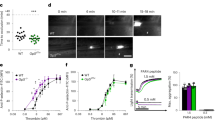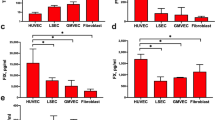Abstract
THROMBIN, a coagulation protease generated at sites of vascular injury, activates platelets, endothelial cells, leukocytes and mesenchymal cells1,2. A G-protein-coupled receptor that is proteolytically activated by thrombin3 is a target for drug development aimed at blocking thrombosis, inflammation and proliferation. Here we show that although disruption of the thrombin receptor (tr) gene in mice causes about half of the tr-/- embryos to die at embryonic day 9–10, half survive to become grossly normal adult mice with no bleeding diathesis. Strikingly, tr-/- platelets respond strongly to thrombin, whereas tr-/- fibroblasts lose their ability to respond to thrombin. We conclude that the thrombin receptor plays an unexpected role in embryonic development, suggesting a possible new function for the 'coagulation' proteases themselves. Moreover, a second platelet thrombin receptor exists, and different thrombin receptors have tissue-specific roles. This may allow development of therapeutics that will selectively block thrombin's different cellular actions.
This is a preview of subscription content, access via your institution
Access options
Subscribe to this journal
Receive 51 print issues and online access
$199.00 per year
only $3.90 per issue
Buy this article
- Purchase on Springer Link
- Instant access to full article PDF
Prices may be subject to local taxes which are calculated during checkout
Similar content being viewed by others
Author information
Authors and Affiliations
Rights and permissions
About this article
Cite this article
Connolly, A., Ishihara, H., Kahn, M. et al. Role of the thrombin receptor in development and evidence for a second receptor. Nature 381, 516–519 (1996). https://doi.org/10.1038/381516a0
Received:
Accepted:
Issue Date:
DOI: https://doi.org/10.1038/381516a0
This article is cited by
-
The mechanism of oleic acid inhibiting platelet activation stimulated by collagen
Cell Communication and Signaling (2023)
-
Thrombin acts as inducer of proinflammatory macrophage migration inhibitory factor in astrocytes following rat spinal cord injury
Journal of Neuroinflammation (2022)
-
The GPIb-IX complex on platelets: insight into its novel physiological functions affecting immune surveillance, hepatic thrombopoietin generation, platelet clearance and its relevance for cancer development and metastasis
Experimental Hematology & Oncology (2022)
-
PAR-1 is a novel mechano-sensor transducing laminar flow-mediated endothelial signaling
Scientific Reports (2018)
-
Aptamer-based sandwich-type biosensors
Journal of Biological Engineering (2017)
Comments
By submitting a comment you agree to abide by our Terms and Community Guidelines. If you find something abusive or that does not comply with our terms or guidelines please flag it as inappropriate.



